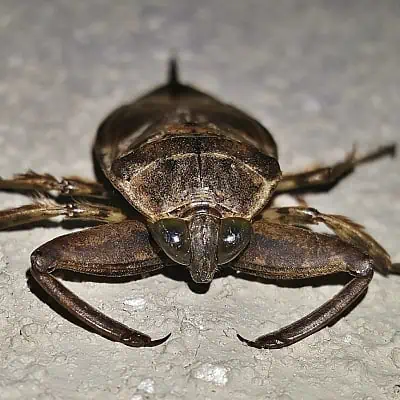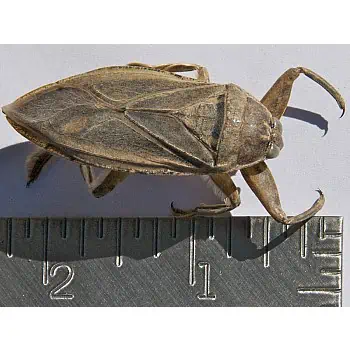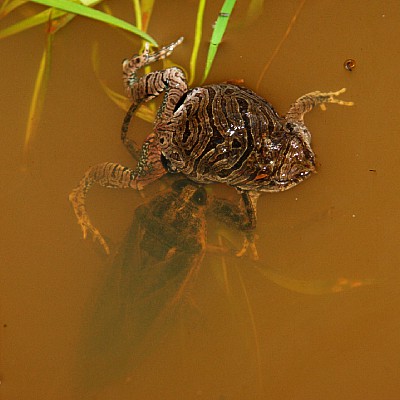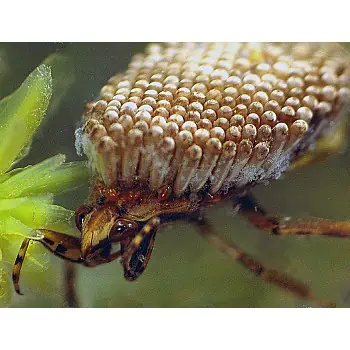
Giant water bugs, also known not-so-affectionately as toe-biters, are one semi-aquatic insect that most people are somewhat familiar with. They’re famously predatory, with piercing-sucking mouthparts that give them a rather perturbing appearance, a trait that Hemipterans are rather known for. However, this creepy-looking creature might just be the world’s most misunderstood and undervalued insect – they’re vitally important to the overall health of the aquatic ecosystems in which they’re found!
In Southeast Asian cultures, it’s not uncommon to find these large insects in markets as a delectable cuisine, whether raw, fried, or boiled. In the western hemisphere, giant water bugs are commonly found in mucky rice paddies (where they are, indeed, toe-biters as they get stepped on frequently). Rice farmers often harvest them for themselves when found or sell them in markets.
With over 170 species, giant water bugs exist natively almost worldwide with the exception of the poles and Europe, though fossils show that they once thrived in the latter as well. There’s more than meets the eye with these Hemipterans, though, as they provide key ecosystem services (read about these in the last section).
What Do Giant Water Bugs Look Like?

Like most other members of the family Belostomatidae, giant water bugs possess specially adapted mouthparts. Their strong beak is used to pierce their prey, while their needle-like rostrum injects a toxin to paralyze their prey and enzymes to essentially digest and liquefy them, then sucks out the juices. They also have jointed legs, the front two of which have been modified to be pincers with small, hooked claws for grabbing and immobilizing prey.
Lethocerus is the genus that contains the largest species within this family – giant water bugs can range in size from only a couple of centimeters to nearly half a foot in length! The larger water bugs tend to exist in the semi-tropical regions of South America and Asia, with Lethocerus americanus in North America averaging around two inches.
As you may know, insects don’t possess lungs like we do. Instead, they have tiny pores called spiracles that collect oxygen and transfer it to tubes known as tracheae, which then diffuse the oxygen where needed. But…how does an insect that can spend months at a time underwater get said oxygen? Giant water bugs actually have two really unique adaptations for this!
We’ll cover the weirdest one first. In short, they breathe through their butts. They have two long, tubular, retractable appendages that extend from their abdomen to their rear. When oxygen is needed, giant water bugs will come toward the surface of the water and tip themselves at an angle so that these anatomical snorkels (and their butt) can breach the surface of the water and pull in some oxygen. When they dive back down, another adaptation allows them to carry an air bubble tucked just beneath their wings, which will gradually diffuse into their body through the aforementioned spiracles while they’re underwater.
Giant Water Bug Habitats – Where Do They Live?

Giant water bugs are often associated with poor, turbid water conditions – but this isn’t usually the case. In fact, giant water bugs need relatively healthy water that supports a variety of insects and animals for them to feed on, and plants to provide a safe haven for spawning and young.
L. americanus can be found in just about any non-polluted stream, bog, creek, lake, or pond with slow-moving or still water with vegetation and a bottom layer of mud, leaves, and detritus. During the warmer months, the plants and mud provide the perfect hiding spot to ambush prey, while protecting them from the cold in the winter.
From spring through autumn, giant water bugs can also be found flying about to seek out new aquatic habitats for spawning. They are drawn to lights, and sometimes are found in large numbers in residential areas buzzing about street lights or backyard bulbs. In the winter, they burrow deep into mud for several months of dormancy or in warmer areas may simply move to deeper, warmer waters that won’t freeze.
The greatest threats to giant water bugs are habitat loss and degradation – over 50% of the natural ponds worldwide have disappeared in the last several decades, and nearly 70% of all vitally important wetlands have also been destroyed in favor of agriculture and urban development. These ecosystems aren’t just essential for giant water bugs, but people, too.
Another significant threat to these important aquatic predators is artificial lighting. Like other nocturnal insects, giant water bugs are drawn to light. As a result, during mating season they can be found flocking to street lamps and even the headlights of cars, where they die not long after due to starvation, inability to find a new wetland home, or being hit by cars or purposely killed by people. Learn why these guys, and fellow insects, are suffering major population crashes of upwards of 70% and why that matters here. Also know that your pond is a safe haven for wildlife, and can help them more than you might guess!
What Do Giant Water Bugs Eat? (Lethocerus americanus Diet)

Thanks to their formidable, impeccably evolved morphology, giant water bugs can eat prey items as much as 50 times their own size! This primarily includes tadpoles, other insects (including mosquito larvae!), fish, frogs, and crustaceans, but they’ve also been known to catch and immobilize larger prey like snakes, turtles, young waterfowl, and muskrats.
When hunting, giant water bugs will either partially submerge themselves in mud or cling to the underwater stem of a plant and wait for prey to unwittingly cross their path. They are incredibly fast opportunistic hunters, and strong to boot – taking down larger prey like turtles or ducklings can take several hours, and giant water bugs will hold on tight, waiting for their prey to tire out and the digestive enzymes to do their work.
Despite their tenacious nature, there are some creatures that eat giant water bugs (particularly the larvae and juveniles). Some crayfish, large bullfrogs, birds, and skilled predatory fish like pike feed on adults, while giant water bug eggs and small young are eaten by many fish species, frogs, and even other giant water bugs.
Will Giant Water Bugs Bite Humans? Are They Toxic?
In short, yes and yes. But they really don’t prefer to attack us and generally try to keep their distance – just don’t step on them or pick them up! I once swam with some as a kid and didn’t even realize it until I got out of the water, at which point they came out of hiding and resumed swimming about. Certainly a bit freaky as I didn’t know what they were at the time, but overall a harmless experience.
If you harass them or accidentally step on one, it’s possible you’ll get a sharp bite. This will be painful, but should not produce any lasting effects and their toxin is not potent enough to harm humans beyond some initial pain and discomfort at the site of the bite. Give them their space, and they’ll do the same for you. Do keep all of this in mind if you have pond fish – large koi are likely safe, but smaller fish might get attacked.
The Life Cycle of Giant Water Bugs

Giant water bugs typically mate and lay their eggs in late spring and early summer. The male and female spar to test each other’s fitness and compatibility, then appear to “dance” underwater before mating. While some species of giant water bug lay their eggs on the backs of the male, where he protects them until hatching, Lethocerus americanus females typically lay their eggs on vegetation at the edge of the water.
Regardless of the species, giant water bug females have been known to remove the eggs of other females from a plant or a male’s back and replace them with her own. Females also cease responsibility after laying the eggs while males guard them until they hatch. The males even take parenting a step further, using their legs to move water over the eggs to amplify oxygen diffusion and prevent the growth of any mold or algae on them.
Metamorphosis from egg to nymph usually occurs within about two weeks, with the young being predatory from the get-go, feeding mostly on the small larva of other aquatic insects. Depending on temperature and food availability, nymphs become adults within one to two months, shedding their juvenile exoskeleton as many as five times to be replaced ultimately by a larger, thicker adult exoskeleton. At this point, they develop their wings and are able to exit the water in search of mates and new habitat. And so the process begins anew!
Adult giant water bugs live for an average of one year, though can live longer if they’re able to successfully overwinter.
How to Attract Giant Water Bugs to Ponds – Are They Beneficial?

Giant water bugs are incredibly beneficial! They are considered a top predator, and much like well-known top predators like crocodiles, leopards, and wolves, they shape the ecosystems they’re found in. Without top predators, prey species would reproduce out of control and utterly deplete the ecosystem (recall what happened to Yellowstone National Park when the wolves were extirpated and cervid populations (elk & mule deer) boomed out of control for seven decades).
Similarly, giant water bugs are essential to controlling the populations of insects like mosquitos (they readily gobble up mosquito larvae) and midges, as well as mollusks like snails, that would otherwise overtake aquatic habitats. This is particularly important in waterbodies where fish are absent or low in number – without some form of predator, whether fish or giant water bug, some insects would rise above the system’s carrying capacity and damage plants as well as pose a potential health risk to wildlife and humans.
Conversely, no insects at all would also lead to an ecosystem collapse, as they form the base of many food chains. A balance of predator and prey is key! Therefore, if you wish to have giant water bugs in your pond, you need to make it suitable for other life, as well.
This means incorporating pond plants to help naturally clean and oxygenate the water while also providing food and habitat. Protective places like rocks and pieces of wood, PVC, etc. can be placed along the pond’s bottom for larvae to safely develop. Furthermore, water should have some movement to prevent stagnation, but not too much – giant water bugs, and many other beneficial aquatic invertebrates, for that matter, prefer slow-moving water. In addition, having a layer of natural mud on the bottom of your pond will greatly increase the chances of a couple of giant water bugs moving in.
What if I Don’t Want Giant Water Bugs in My Pond?
On the other hand, if you don’t wish to attract giant water bugs simply keep any muck or detritus from settling to the bottom of your pond. You can also incorporate higher powered pond pumps or skimmers to increase water flow.
Under what circumstances would you want to have giant water bugs? As mentioned above, an ecosystem devoid of any predators will not survive for long. Therefore, we recommend trying to draw in giant water bugs if your pond lacks fish. You can still have them if you have fish, but keep in mind that the bugs may attack smaller/younger fish. Large fish are the most able to live in harmony with these undervalued bugs.

